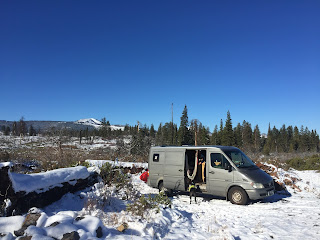Materials: (I will link to the products when I get on a computer, typing on my phone!)
Solar
Goal Zero Boulder 90 solar panel
Goal Zero Hinge Base mounts
3M VHB 5952 tape
Rubber gasket
White silicone caulk
Fan
Fantastic Fan
White silicone caulk
Jigsaw blade for cutting metal
3M VHB 5952 tape
Rubberish weather stripping
Steps:
Solar. On Silas I used two Boulder 30 panels, which was definitely sufficient for our needs. However, the Boulder 90 is now available so I thought, why not? When I did my first van, there were no mounting options that were pre-made so my brother machined some custom adjustable mounts for me which we screwed into the roof. Now they make the Goal Zero bracket mount.
1. Decide on positioning. We decided to mount the panel on the front of the roof in case we eventually put a kayak rack on the back of the roof for Brian's boat. We put it on the side (vs. centered) so we can hopefully reach it to brush snow off, and we can fit another Boulder 90 next to it if we decide we want another.
2. You will want to clean the roof of your van and the bottom of the mounts with rubbing alcohol and a clean cloth.
3. Attach your mounts to the panel. The mounts don't come with any instructions or suggestions for how to use them. I figured out how they fit onto the panel and Brian tightened them down with an allen wrench.
4. Mystery tape. The Goal Zero mounts come with a bunch of GIANT screw holes in them. If you were to use screws to lock them onto the roof you would be making a lot of big holes in your roof. We had heard of another option- 3M VHB tape, which supposedly can replace welding in certain situations. I saw examples of other people using it but couldn't really find concrete information on it. My brother helped me choose one of the different formulas, 5952, which I think is good for painted surfaces. There are a lot of different VHB tapes, so hopefully we chose the right one. Anywho, make sure it isn't too cold out when you're applying the tape. Stick it onto the mounts, then peel off the backing and stick it onto the roof. Apply pressure and it will be sticky right away, so make sure you position it right on the first try. I think it reaches full strength about 24 hours after you apply it.
5. Wiring. After the panel was mounted, we drilled a 1/2" hole in the roof. If you want a smaller hole, you can cut the fat end part of the wire off, thread it through the roof, and then reattach the end. We put a rubber gasket around the wire, plugged the hole with it, and sealed it off with silicone caulk. Done!
Fan. Who is ready to cut a big hole in the roof of their van? You are! Well, I actually wasn't so I had my brother do it, just like I did on the last van!
1. Positioning. Figure out where you want your fan. Based on where our windows will be and where our door is, we positioned the fan slightly behind the kitchen area and in front of the bed so it can be ventiliation for cooking and also keep us cool while sleeping. Try to find a spot on your roof where the fan can potentially fit between ribs on the rooftop and definitely put it somewhere where you won't have to cut through the internal roof ribs/supports. You can trace the fan hole (it should come with a stencil) on the inside of the van and then drill holes in the corners. Once on top of the van, line the stencil up with the corners and trace it again. (We actually didn't do this and just measured sort of how far it should be on the roof and we almost cut through a ceiling rib... oops).
2. Cut the hole! We drilled a pilot hole and then put the jigsaw blade in and began trimming. It cuts really easily. You can line your hole with tape so you don't scratch the paint with the jigsaw.
3. Plop the fan in the hole. Make sure it fits and make sure it is facing the right way so the dome doesn't get ripped off if you forget to put it down before driving.
4. Seal. Once you've checked the fit you are ready to stick the fan in for good. We had a bunch of leftover 3M tape from the panel, so we decided to use it on the fan to avoid drilling more holes in the roof. We put some weather stripping in the low points of the ribs to try to make a more even surface. I've also seen people pound down the ribs where the fan is so it is all flat. We stuck the 3M tape on van, peeled the backing, and stuck the fan in. We then used a caulk gun and sealed all the edges and the holes in the fan frame where the screws would have gone if we used them.









































